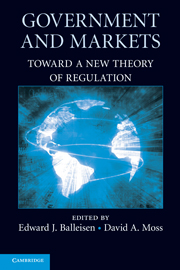Book contents
- Frontmatter
- Contents
- Acknowledgments
- Contributors
- Introduction
- SECTION I BEYOND MARKET FAILURE
- SECTION II BEYOND THE ECONOMIC THEORY OF POLITICS
- SECTION III BEYOND COMMAND AND CONTROL
- 10 What Opportunity Is Knocking? Regulating Corporate Governance in the United States
- 11 Taxation as a Regulatory Tool: Lessons from Environmental Taxes in Europe
- 12 Redesigning Regulation: A Case Study from the Consumer Credit Market
- 13 Origins and Regulatory Consequences of the Subprime Crisis
- 14 The Prospects for Effective Coregulation in the United States: A Historian's View from the Early Twenty-First Century
- 15 Deregulation Theories in a Litigious Society: American Antitrust and Tort
- 16 Markets in the Shadow of the State: An Appraisal of Deregulation and Implications for Future Research
- Conclusion
- Index
- References
12 - Redesigning Regulation: A Case Study from the Consumer Credit Market
Published online by Cambridge University Press: 20 January 2010
- Frontmatter
- Contents
- Acknowledgments
- Contributors
- Introduction
- SECTION I BEYOND MARKET FAILURE
- SECTION II BEYOND THE ECONOMIC THEORY OF POLITICS
- SECTION III BEYOND COMMAND AND CONTROL
- 10 What Opportunity Is Knocking? Regulating Corporate Governance in the United States
- 11 Taxation as a Regulatory Tool: Lessons from Environmental Taxes in Europe
- 12 Redesigning Regulation: A Case Study from the Consumer Credit Market
- 13 Origins and Regulatory Consequences of the Subprime Crisis
- 14 The Prospects for Effective Coregulation in the United States: A Historian's View from the Early Twenty-First Century
- 15 Deregulation Theories in a Litigious Society: American Antitrust and Tort
- 16 Markets in the Shadow of the State: An Appraisal of Deregulation and Implications for Future Research
- Conclusion
- Index
- References
Summary
The consumer credit market is broken. Businesses have learned to exploit customers' systematic cognitive errors, selling complex credit products that are loaded with tricks and traps. Because customers cannot see or understand complete credit terms until it is too late, the market no longer operates to achieve competitive efficiency. Instead, creditors engage in a race to the bottom, boosting profits by offering ever-riskier products that families are poorly equipped to handle. The consequences are serious: Americans are sinking deeper in debt each year, and defaults, foreclosures and bankruptcies are on the rise.
The regulatory framework that once controlled consumer credit is now in tatters. From colonial times until 1979, state-based usury laws were the central feature of consumer protection. In 1979, a Supreme Court interpretation of ambiguous language in a national banking law effectively ended state usury laws. Congress could easily have reversed the opinion by clarifying the language, but it turned away while this critical consumer protection vanished. By the 1990s, product innovation from payday lending to universal default to creative mortgage financing took root largely outside the purview of any regulatory body. Truth-in-Lending laws, which were designed to supplement usury protection, failed to keep pace with market changes. The Federal Reserve, the Office of the Controller of the Currency, the Office of Thrift Supervision, and other federal and state agencies regulate various financial institutions, but the mission of these regulators is aimed squarely at protecting the banks and the stability of the overall financial system, with scant attention to consumer protection.
- Type
- Chapter
- Information
- Government and MarketsToward a New Theory of Regulation, pp. 391 - 418Publisher: Cambridge University PressPrint publication year: 2009
References
- 2
- Cited by

